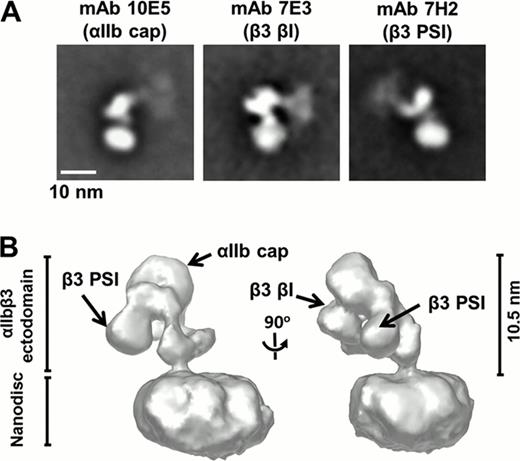Abstract
Abstract 92
Integrin αIIbβ3 is a heterodimeric transmembrane signaling receptor that plays a central role in hemostasis and thrombosis. Both two-dimensional (2D) electron microscopic (EM) images of detergent-solubilized intact αIIbβ3 and the x-ray crystallographic structure of the unliganded αIIbβ3 ectodomain show a bent, compact conformation, but these do not provide information about the orientation of the ectodomain relative to the membrane. 2D EM of intact αIIbβ3 inserted into a lipid nanodisc was interpreted as consistent with the crystal structure, with the head region pointing toward the membrane. Three-dimensional (3D) reconstructions of detergent-solubilized αIIbβ3 by transmission cryo-electron microscopy (cryo-EM), small angle neutron scattering (SANS), and small angle x-ray scattering (SAXS) have been interpreted, however, as showing the head region either pointing toward (SANS, SAXS) or away (cryo-EM) from the membrane. Moreover, it has been difficult to fit the crystallographic structure of the receptor with the 3D data from these other methods. To obtain a 3D reconstruction of intact αIIbβ3 in a phospholipid bilayer in the absence of detergent, we inserted purified, intact single αIIbβ3 molecules into nanodiscs, and after removing αIIbβ3 molecules in the active and extended conformations, studied them by negative stain EM, using the random conical tilt method and additional refinements to create a 3D electron density map with a resolution by Fourier shell correlation of 20.5 Å. We employed mAbs to the αIIb cap domain (10E5), β3 βI domain (7E3), and β3 PSI domain (7H2), to establish landmarks in the EM map. The 3D reconstruction indicates that inactive αIIbβ3 adopts a bent, compact conformation, but the head domain containing the αIIb β-propeller and β3 βI domains is on the top of ectodomain, pointing away from the lipid bilayer. Moreover, unlike in the crystal structure of the ectodomain, the lower leg domains in the 3D reconstruction are not straight, parallel, and adjacent throughout their length, but rather have complex shapes, move in different directions, and only join as they near the lipid bilayer and transmembrane domains. Our reconstruction is consistent with mAb kinetic binding data using mAbs 10E5 and 7E3 and appears to be able to reconcile the SANS and cryo-EM data. Instead of the jackknife-like dive conformation of the crystal structure, with a single bend at the waist, our 3D reconstruction suggests more of a deep knee bend conformation, with bends at both the waist and knees. The deadbolt hypothesis of integrin activation postulates an interaction between the β3 β tail domain and the β3 βI domain in the inactive receptor. In our reconstruction, however, the β3 β tail domain and the β3 βI domain are not juxtaposed. The jackknife hypothesis of activation postulates that the headpiece faces toward the membrane in the inactive, bent conformation, limiting ligand access to the binding site, and that activation results in extension of the headpiece away from the membrane to the top of the integrin, providing greater access to the binding site. Our data suggest that despite the head region pointing away from the membrane, its proximity to the membrane may still limit access of ligand.
No relevant conflicts of interest to declare.
Author notes
Asterisk with author names denotes non-ASH members.


This feature is available to Subscribers Only
Sign In or Create an Account Close Modal